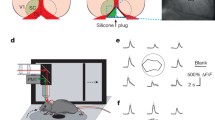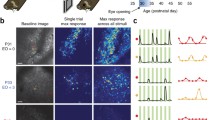Abstract
Directionally selective neurons strongly fire when presented with a preferred direction of motion of a bar and only weakly respond otherwise. Intuition suggests these “specialist” neurons would be better suited to report this stimulus feature to higher visual centers than “generalist” neurons, neurons that broadly modulate their activity to the feature. However, as stimuli are encoded not by one cell but by large neural ensembles, we have studied the role of single-cell receptive field properties in stimulus representation. Using regression error statistics, we compared the performance of direction-of-motion estimators, using ensembles of neurons selectively responding to direction of motion and estimators using ensembles not specializing to direction. We found that direction-selective ensembles were no better at representing a bar's direction of motion than nonselective ensembles. Quite the opposite, the nonselective unit ensembles provided a better estimate of the direction (standard deviation of the error of 33°) than the direction-selective ensembles (standard deviation of the error of 42°). The nonselective neurons provided information through a latency code that is apparent only when a neuron's activity is considered in the context of the responses of neighboring neurons. These results suggest that models utilizing both generalist and specialist neurons may better reflect the encoding mechanisms that take place in sensory pathways.
Similar content being viewed by others
REFERENCES
Abeles, M. Corticonics, Neural Circuits of the Cerebral Cortex. Cambridge, UK: Cambridge University Press, 1991, 280 pp.
Blasdel, G. G., and G. Salama. Voltage-sensitive dyes reveal a modular organization in monkey striate cortex. Nature 321:579–585, 1986.
Brindley, G. S., and W. S. Lewin. The sensations produced by electrical stimulation of the visual cortex. J. Physiol. 196:479–493, 1968.
Crair, M. C., E. S. Ruthazer, D. C. Gillespie, and M. P. Stryker. Ocular dominance peaks at pinwheel center singularities of the orientation map in cat visual cortex. J. Neurophysiol. 77:3381–3385, 1997.
Dobelle, W. H. Artificial vision for the blind by connecting a television camera to the visual cortex. ASAIO J. 46:3–9, 2000.
6Dobson, A. J. An Introduction to Generalized Linear Models, 2nd ed. Boca Raton, FL: CRC Press, 2002, 225 pp.
7Field, D. J., A. Hayes, and R. F. Hess. Contour integration by the human visual system: Evidence for a local "association field." Vis. Res. 33:173–193, 1993.
8Fisher, N. I., and A. J. Lee. Regression models for an angular response. Biometrics 48:665–677, 1992.
9Fisher, N. I. Statistical Analysis of Circular Data. Cambridge, UK: Cambridge University Press, 1993, 277 pp.
Gattass, R. Columnar organization in area mt in primates: Pinwheels and fractures revealed by electrophysiology. In: Cooperative Dynamics of Neural Systems. Pucon, Chile: Gran Hotel Pucon, 2002.
Heitger, F., L. Rosenthaler, R. von der Heydt, E. Peterhans, and O. Kubler. Simulation of neural contour mechanisms: From simple to end-stopped cells. Vis. Res. 32:963–981, 1992.
Hubel, D. H., and T. N. Wiesel. Receptive fields, binocular interaction and functional architecture in the cat's visual cortex. J. Physiol. (Lond.) 160:106–154, 1962.
Hubel, D. H., and T. N. Wiesel. Receptive fields and functional architecture of monkey striate cortex. J. Physiol. (Lond.) 195:215–243, 1968.
Hubener, M., D. Shoham, A. Grinvald, and T. Bonhoeffer. Spatial relationships among three columnar systems in cat area 17. J. Neurosci. 17:9270–9284, 1997.
Kovacs, I. Gestalten of today: Early processing of visual contours and surfaces. Behav. Brain Res. 82:1–11, 1996.
Lee, T. S., D. Mumford, R. Romero, and V. A. Lamme. The role of the primary visual cortex in higher level vision. Vis. Res. 38:2429–2454, 1998.
Levick, W. R., and L. N. Thibos. Analysis of orientation bias in cat retina. J. Physiol. 329:243–261, 1982.
Li, Z. A neural model of contour integration in the primary visual cortex. Neural Comput. 10:903–940, 1998.
Mardia, K. V., and P. E. Jupp. Directional Statistics, 2nd ed. New York: Wiley, 2000, 429 pp.
Marr, D. Vision: A Computational Investigation into the Human Representation and Processing of Visual Information. San Francisco: Freeman, 1982, 397 pp.
Nelder, J. A., and R. W. M. Wedderburn. Generalized linear models. J. Roy. Stat. Soc., Ser. A. 135:370–384, 1972.
Nordhausen, C. T., E. M. Maynard, and R. A. Normann. Single unit recording capabilities of a 100 microelectrode array. Brain Res. 726:129–140, 1996.
Nothdurft, H.-C. Different approaches to the coding of visual segmentation. In: Computational and Psychophysical Mechanisms of Visual Coding, edited by M. Jenkin and L. Harris. Cambridge, UK: Cambridge University Press, 1997, pp. 20–43.
Orban, G. A. Quantitative electrophysiology of visual cortex neurons. In: The Neural Basis of Visual Function, edited by A. G. Leventhal. Boca Raton, FL: CRC Press, 1991, pp. 173–222.
Reid, R. C., R. E. Soodak, and R.M. Shapley. Directional selectivity and spatiotemporal structure of receptive fields of simple cells in cat striate cortex. J. Neurophysiol. 66:505–529, 1991.
Rencher, A. C. Linear Models in Statistics. New York: Wiley, 2000, 578 pp.
Schmidt, E. M., M. J. Bak, F. T. Hambrecht, C. V. Kufta, D. K. O'Rourke, and P. Vallabhanath. Feasibility of a visual prosthesis for the blind based on intracortical microstimulation of the visual cortex. Brain 119(Pt. 2):507–522, 1996.
Shoham, S., M. R. Fellows, and R. A. Normann. Robust, automatic spike sorting using mixtures of multivariate t-distributions. J. Neurosci. Methods 127:111–122, 2003.
Skottun, B. C., R. L. De Valois, D. H. Grosof, J. A. Movshon, D. G. Albrecht, and A. B. Bonds. Classifying simple and complex cells on the basis of response modulation. Vis. Res. 31:1079–1086, 1991.
Thibos, L. N., and W. R. Levick. Orientation bias of brisktransient y-cells of the cat retina for drifting and alternating gratings. Exp. Brain Res. 58:1–10, 1985.
Thompson, K. G., A. G. Leventhal, Y. Zhou, and D. Liu. Stimulus dependence of orientation and direction sensitivity of cat lgnd relay cells without cortical inputs: A comparison with area 17 cells. Vis. Neurosci. 11:939–951, 1994.
Thompson, K. G., Y. Zhou, and A. G. Leventhal. Directionsensitive x and y cells within the a laminae of the cat's lgnd. Vis. Neurosci. 11:927–938, 1994.
Walraven, J., C. Enroth-Cugell, D. C. Hood, D. I. MacLeod, and J. L. Schnapf. The control of visual sensitivity: Receptoral and postreceptoral processes. In:Visual Preception: The Neurophysiological Foundations, edited by L. Spillman and J. S. Werner. San Diego, CA: Academic Press, 1989, pp. 53–101.
Warren, D. J., E. Fernandez, and R. A. Normann. Highresolution two-dimensional spatial mapping of cat striate cortex using a 100-microelectrode array. Neuroscience 105:19–31, 2001.
Warren, D. J., A. Koulakov, and R. A. Normann. Filling in the map: Estimating receptive field characteristics at locations not sampled by a multielectrode array. In: Society for Neuroscience. Annual Meeting Abstracts, Washington, DC, 2002, Society for Neuroscience.
Worgotter, F., T. Muche, and U. T. Eysel. Correlations between directional and orientational tuning of cells in cat striate cortex. Exp. Brain Res. 83:665–669, 1991.
Yen, S.-C., and L. H. Finkel. Salient contour extraction by temporal binding in a cortical-based network. In: Advances in Neural Information Processing, edited byM. C. Mozer, M. I. Jordan, and T. Petsche. Cambridge,MA: MIT Press, 1997, pp. 915–921.
Zar, J. Biostatistical Analysis, 4 ed. Upper Saddle River, NJ: Prentice-Hall, 1999, 604 pp.
Author information
Authors and Affiliations
Corresponding author
Rights and permissions
About this article
Cite this article
Warren, D.J., Koulakov, A. & Normann, R.A. Spatiotemporal Encoding of a Bar's Direction of Motion by Neural Ensembles in Cat Primary Visual Cortex. Annals of Biomedical Engineering 32, 1265–1275 (2004). https://doi.org/10.1114/B:ABME.0000039360.10535.af
Issue Date:
DOI: https://doi.org/10.1114/B:ABME.0000039360.10535.af




